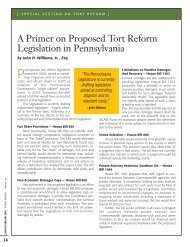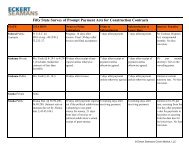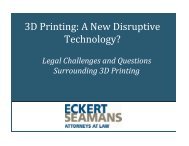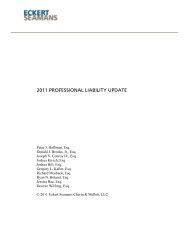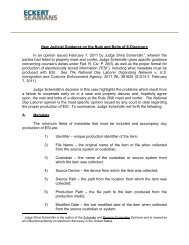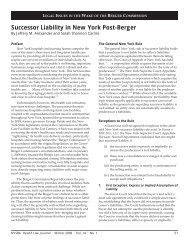(b)(c)other reasonable causes, including the conduct ofthe plaintiff and third persons, are sufficientlyeliminated by the evidence; andthe indicated negligence is within the scope of thedefendant’s duty to the plaintiff . . .Applying this standard, the court held that all three elements were established in thepresent case. First, the court explained, a quadriplegic patient such as Decedent could not fall offan examination table in the absence of negligence. Next, the court held that it was “undisputedthat there [was] no explanation for Decedent’s fall beyond defendants’ negligence.” Finally, thecourt ruled that the indicated negligence was clearly within the scope of Defendants’ duty toPlaintiff’s Decedent. Applying res ipsa loquitur, the Supreme Court held, in turn, that judgmentnotwithstanding the verdict should have been granted in favor of Plaintiff because “no tworeasonable minds could disagree” that Decedent, a quadriplegic incapable of all but the slightestmovements, could have fallen from the operating table in the absence of Defendants’ negligence.The court did find that a fact question remained as to whether the fall had caused Decedent’sdeath, and remanded the case for a new trial on the wrongful death claim and on the issues ofdamages in the survival action.In MacNutt v. Temple University Hospital, 932 A.2d 980 (Pa. Super. Ct. 2007), theSuperior Court upheld the trial court’s decision to preclude Plaintiff from presenting his medicalmalpractice case based on a res ipsa theory in light of the trial court’s finding that Plaintiff hadproduced adequate evidence to support a cause of action based on a standard theory ofnegligence.In MacNutt, Plaintiff alleged that Defendants negligently caused him to sustain a severechemical burn during the second of two surgeries to correct his Thoracic Outlet Syndrome,resulting in various injuries. At trial, Plaintiff intended to proceed based upon theories of bothstandard negligence and res ipsa loquitur. Plaintiff supported his standard negligence theory byoffering the expert testimony of a physician, who opined that Plaintiff suffered a chemical burnas a result of lying in an unconscious state for an extended period of time in a surgicalpreparatory cleansing solution, composed of betadine and alcohol, which pooled under his body.At the close of Plaintiff’s case-in-chief, the trial court precluded Plaintiff fromproceeding on a res ipsa theory in addition to his standard negligence theory, finding thatPlaintiff’s expert had provided sufficient testimony to support a conventional negligence theory.Following a defense verdict, Plaintiff appealed, arguing, inter alia, that the trial court erred byprecluding his res ipsa theory given that his expert opined as to how the burn “could” haveoccurred, but did not offer sufficient testimony to constitute direct evidence of Defendants’negligence. As a result of the court’s ruling, Plaintiff insisted, he was relegated to resting hiscase entirely on the expert’s opinion regarding the betadine pooling as the cause of the burn,which Defendants vigorously attacked and the jury subsequently rejected.Holding that Plaintiff could not establish all three elements of the doctrine of res ipsaloquitur pursuant to Restatement (Second) of Torts § 328(d)(1), the Superior Court affirmed thetrial court’s decision to preclude Plaintiff from proceeding on a theory of res ipsa. The court16
ased its holding on its findings that the nature of Plaintiff’s injury was itself in dispute (andcould, therefore, have occurred without negligence), and that Plaintiff’s counsel elicitedsufficient testimony from his expert witness (i.e. that Plaintiff’s injury was caused by the poolingof betadine solution during surgery) to constitute an adequate cause of action for malpracticebased upon a standard theory of negligence. The Court concluded, in turn, that the case subjudice was not, in reality, a res ipsa case, and that the trial court properly limited Plaintiff toproceeding on a conventional negligence theory.In Asbury v. Mercy Fitzgerald Hosp., No. 06-15525, 2011 WL 3735272 (C.P. Phila.April 14, 2010), aff’d without opinion, 23 A.3d 1078 (Pa. Super. Jan. 10, 2011), the courtheld that plaintiff was permitted to proceed under a res ipsa loquitur theory because shemet her burden, under § 328D(1), of showing that her nerve injury, sustained under thecircumstances of the surgery performed by defendants, did not ordinarily occur in theabsence of negligence. 2011 WL 3735272 at 12. Defendants argued that a res ipsa loquiturinstruction was inappropriate because plaintiff was required, pursuant to Section328D(1)(b), to show that other causes of plaintiff’s injury were impossible. Id. at p 13. Thecourt disagreed, holding that any purported failure by plaintiff to show that other causes ofplaintiff’s injury were impossible did not prevent plaintiff from carrying her burden toeliminate, as required by Section 328D(1)(b), other possible causes of her injury. Id. at 13.More specifically, in order to warrant a res ipsa loquitur instruction, it was sufficient forplaintiff to show that defendants’ alleged negligence was more likely than not the probableexplanation for her injury. Id. at 13. The doctrine of res ipsa loquitur, the court reasoned,would then allow for the jury to resolve how and by whom the plaintiff’s alleged nerveinjury had been sustained. Id.3. Scientific Evidence – The Frye and Daubert StandardsTestimony by experts is governed by Rule 702 of the Pennsylvania Rules of Evidence.Pa. R. Evid. 702. Rule 702 follows the standard announced in Frye v. United States, 293 F. 1013(D.C. Cir. 1923), that requires scientific evidence to have “general acceptance” in the relevantscientific community. Frye, rather than Daubert, is now clearly the test applied in Pennsylvaniastate cases. Conversely, Federal Rule of Evidence 702 follows the modified Daubert standard.See Daubert v. Merrell Dow Pharms., Inc., 509 U.S. 579 (1993).In Ellison v. United States, No. 09-CV-331, 2010 WL 4670359 (E.D. Pa. Nov. 10, 2010),the District Court found the testimony of two expert witnesses reliable in a suit where a patientsuffered a stroke after experiencing hypotension multiple times during an oral surgery. The courtfollowed the Daubert standard and applied a liberal and flexible interpretation of Federal Rule ofEvidence 702 in determining the experts’ reliability.Although the standard of care expert conceded that he did not know whether other oralsurgeons would use or disagree with the standard he proposed, and stated “I think it’s the correctway and that’s my opinion” (emphasis added), the court found that the expert had a reliable basisfor setting forth the procedure as the general standard of care and not merely a personal standardof care. The court found the expert’s testimony reliable even though the expert could not pointto any texts that were specifically relevant, because the expert used indirect references that17
- Page 3 and 4: EMTALA CASES ......................
- Page 5: Filing an Affidavit of Non-Involvem
- Page 8 and 9: II.PROFESSIONAL LIABILITY - AN OVER
- Page 10 and 11: The Superior Court reversed the tri
- Page 12 and 13: to a third party pursuant to the st
- Page 14 and 15: After approximately five months, De
- Page 16 and 17: learned the day after the surgery t
- Page 18 and 19: conduct to the delay in colon cance
- Page 20 and 21: court admitted the expert’s testi
- Page 24 and 25: corroborated his testimony. The cou
- Page 26 and 27: husband’s estate. Plaintiff alleg
- Page 28 and 29: Other notable federal cases arising
- Page 30 and 31: The Superior Court found that in re
- Page 32 and 33: § 1303.512(b). The court, however,
- Page 34 and 35: In Neidig v. United States, No. 07-
- Page 36 and 37: Additionally, the Supreme Court not
- Page 38 and 39: were not indicated for her conditio
- Page 40 and 41: surgeon is the same as it would be
- Page 42 and 43: It should be noted that the Superio
- Page 44 and 45: Finally, the court held that the tr
- Page 46 and 47: The Supreme Court of Pennsylvania r
- Page 48 and 49: nurses deviating from applicable st
- Page 50 and 51: certainty, the court reviews expert
- Page 52 and 53: Under Pennsylvania law, the Court n
- Page 54 and 55: testimony, Defendant presented his
- Page 56 and 57: Following Cooper v. Roberts, 286 A.
- Page 58 and 59: Plaintiff developed chronic diarrhe
- Page 60 and 61: where payment is made by Medicaid w
- Page 62 and 63: accomplished. In Valles v. Albert E
- Page 64 and 65: In 1980, the Pennsylvania Superior
- Page 66 and 67: Plaintiff had a routine monitoring
- Page 68 and 69: Plaintiff’s Contract ClaimsThe Co
- Page 70 and 71: is a failure to report changes in a
- Page 72 and 73:
unit to assure post-surgical patien
- Page 74 and 75:
sliced his wrist and arm with a raz
- Page 76 and 77:
licensed professionals for whom the
- Page 78 and 79:
(c)Limitations of Corporate Neglige
- Page 80 and 81:
Even more recently, our Superior Co
- Page 82 and 83:
(a)HMO IssuesIn McClellan v. Health
- Page 84 and 85:
affidavit submitted by Defendants o
- Page 86 and 87:
treatments while at VA’s faciliti
- Page 88 and 89:
[s]ubstantively, we believe that a
- Page 90 and 91:
The party claiming the benefit of t
- Page 92 and 93:
deprive (him) of civil rights guara
- Page 94 and 95:
found that the District Court was w
- Page 96 and 97:
With respect to fraudulent concealm
- Page 98 and 99:
would be applied in situations wher
- Page 100 and 101:
they had not raised them in the cou
- Page 102 and 103:
(a)Informed ConsentUnder MCARE, a p
- Page 104 and 105:
civil enforcement provisions and ma
- Page 106 and 107:
MCARE also changes the manner in wh
- Page 108 and 109:
whose death, in 2005, was allegedly
- Page 110 and 111:
vicariously liable if the plaintiff
- Page 112 and 113:
health center or its equivalent or
- Page 114 and 115:
In Pennsylvania Medical Society, th
- Page 116 and 117:
to any professional who is alleged
- Page 118 and 119:
Since the 2005 amendments, there ha
- Page 120 and 121:
ule, but who intentionally ignores
- Page 122 and 123:
the original Complaint was delivere
- Page 124 and 125:
foreclose all challenges against th
- Page 126 and 127:
number of boxes), which was support
- Page 128 and 129:
questions of professional judgment
- Page 130 and 131:
deviated from any professional stan
- Page 132 and 133:
The Third Circuit affirmed the Dist
- Page 134 and 135:
claims and cross-claims remain agai
- Page 136 and 137:
By an Amendatory Order dated March
- Page 138 and 139:
The court acknowledged that there i
- Page 140 and 141:
apply and that the trial court misa
- Page 142 and 143:
Barbados had enough litigation-spec
- Page 144 and 145:
E. Preemption of Vaccine Design Def
- Page 146 and 147:
2. Pa. R. Civ. Pro. 1036.1 - Reinst
- Page 148 and 149:
Barrick, at *34-35.Furthermore, the
- Page 150 and 151:
(b) the utility of the defendant’
- Page 152 and 153:
2006). In this case, Plaintiffs bro
- Page 154 and 155:
B. Elements of a Cause of Action fo
- Page 156 and 157:
decision in Muhammad precluded Mr.
- Page 158 and 159:
considered speculative “only if t
- Page 160 and 161:
underlying cause of action involved
- Page 162 and 163:
In Capital Care Corp., the Superior
- Page 164 and 165:
The court found, however, to state
- Page 166 and 167:
of reasonable diligence. The standa
- Page 168 and 169:
not be set aside. On July 7, 2005,
- Page 170 and 171:
complete bar to recovery. Since a l
- Page 172 and 173:
On appeal, Plaintiffs claimed that
- Page 174 and 175:
In Liggon-Redding, 659 F.3d at 265,
- Page 176 and 177:
elieved of those minimum standards
- Page 178 and 179:
elevant to the proceedings, the com
- Page 180 and 181:
establish professional misconduct b
- Page 182 and 183:
Upholding the Superior Court’s Or
- Page 184 and 185:
Id.Rejecting revocation and suspens
- Page 186 and 187:
order as a sanction under Rule 4019
- Page 188:
{1009912]182



